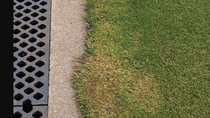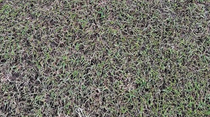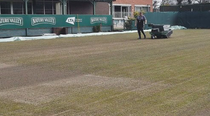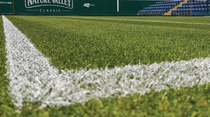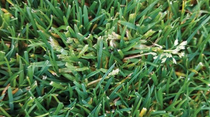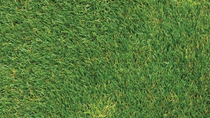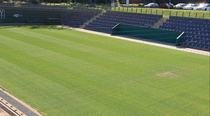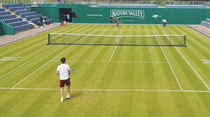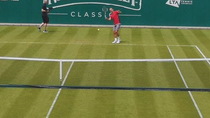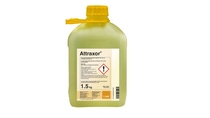BASF Professional & Specialty Solutions
A different approach to renovations at the Edgbaston Priory Club
To really understand the point of this article, we need to begin at the end. Assistant Grounds Manager at The Edgbaston Priory Club John Lawrence explains that the 'why' is perhaps the most important part of this article. Knowledge gives us the ability to make informed decisions. However, to understand the reasoning for diving so far in to the 'why' you need to know what we think we've concluded, and for that reason we'll start with our conclusion: "We believe that Attraxor will prove to be the next revolutionary product to become commonplace in the turf manager's arsenal."
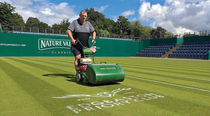
Centre Court being mown during the playing season by Grounds Manager, David Lawrence
Now we accept that we're making a bold claim, but that bold claim really is the justification for this article. The story began back at BTME in January 2020. In the full context of 2020, Harrogate feels like an eternity ago. That being said however, it was the point at which we first came across Attraxor, through Dan Hughes (Head of Commercial for Agrovista Amenity) who was keen to introduce us to the product and some of the BASF delegates who were also attending the show. Of course, anybody who knows my father Dave (and by proxy myself) will be well aware that selling 'product' to us is a tricky proposition. Dave in particular is proud of his reputation amongst sales reps for being, to put it politely, immune to a sales pitch, and so it stands to reason that the work Dan, and Mark Allen (Technical Sales Manager at Agrovista Amenity), have put in to building a relationship to a point where they can suggest a product to us without an upset word is quite an achievement!
Based on the level of trust we have in Dan and Mark, we left the show with plenty of literature to review, and having had conversations about some potential trial work with Attraxor to assess its effectiveness as part of the management of our eight grass courts. In a normal year, we'd have likely looked at establishing how we'd progress things in relation to Attraxor, identified some areas we could use it, and started a slow assessment of the product in order to decide if it complemented what we aim to achieve with our courts. However, 2020 wasn't a normal year! The Covid-19 pandemic had a major impact on our 2020 season; for one our main spectator event of the season, the Birmingham Classic Ladies international tennis tournament, was cancelled, along with the rest of the grass court season, including the Wimbledon Championships. This change in our calendar necessitated a change in focus on our part, and as facilities were allowed to re-open post lockdown, it became evident that we would need to extend our member grass court season in order to increase the number of courts available for use. Firstly, because indoor facilities (which make up a quarter of our available courts) would be off limits, and secondly, because for large parts of the year doubles was not permissible, meaning that court capacity effectively dropped during these periods by 50%, as only singles tennis could be played.
This need to create additional capacity meant that we needed to extend our playing season, firstly at the start of our season. We worked hard to ensure that as soon as restrictions facilitated a re-opening of tennis we would have grass courts ready, and this is indeed something we accomplished. It also meant stretching out the back end of our season, in turn pushing back our end of season renovations, thus reducing our window to complete works on the courts to ensure their readiness for the 2021 season. Whilst this was a trade-off that had to be made, it created areas where compromises needed to be made. For one, could we risk heavy, invasive works if the courts would not then have time to recover prior to the winter?
For example, in a normal year, we would start renovating our centre court in early August, our three practice courts in mid to late-August, and then our four match courts sequentially through September, with the last two generally coming out of use in the last week of the month. With 2020 not being a 'normal' year, and capacity pressures mandating a longer grass court season, we put ourselves in a position whereby we would keep all eight courts open, including Centre Court, until the 1st of September, at which point we would start dropping courts out sequentially, but still leaving some in play until later in the month.
That decision, whilst in the best interests of our members and therefore the club, did create some challenges. Most obviously that we would be condensing down works that we would normally spread over eight weeks into just four! This put pressure on manpower, especially as we were still open, and as well as maintaining the wider grounds, still had to maintain any courts that hadn't yet been taken out of play. Additionally, the time frame meant equipment became a precious resource.
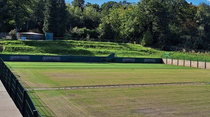
Court 1 growing in after renovation with Courts 2 and 3 part scarified
The obvious way to counter having half the time to do a job is to somehow double productivity. However, our financial position doesn't dictate a bottomless pit of money (in fact, reality is far from it!) and so we weren't able to increase productivity by using twice the manpower with twice the equipment!
The other issue with condensing the works down later in the year is weather. As you move later into the year, rainfall becomes more prevalent and temperatures begin to decrease; not exactly the ideal combination for completing renovation works and getting grass seed to germinate! These challenges meant we needed to think outside the box in terms of our approach to renovations; doing exactly what we normally would in different circumstances would likely lead to a less desirable, different result. However, in most cases, processes can't be altered without having a negative impact on the end result. For example, we couldn't realistically save any time on reseeding, as this would mean not seeding at all!
The only area where it would be realistic to make alterations was in the way we clean the court out, prior to aeration, seeding and dressing. In a normal year, we would make a number of passes with a tractor mounted Graden scarifier to remove any thatch build up from that year's playing season, and combine that with some intense verti-cutting and mechanical brushing to remove any undesirable grass from the remaining sward. In simplistic terms, and while there is some cross over in what the operations achieve, we scarify to remove the thatch, and verti-cut and brush to remove undesirable grasses - namely Poa Annua (Annual Meadow Grass).
We therefore made a decision to scarify at a lesser depth than we normally would, with a view that, as our courts are heavily scarified every year and there is very little thatch build up through the season because of our other maintenance practices, a one off less intense renovation would yield, at worst, a negligible negative impact on the quality of the playing surface. This less deep and intense scarification would also allow the courts to recover more quickly after renovations were complete, giving us more time before winter fully set in to carry out any additional autumn works we deemed necessary.
The other area that we altered was to reduce the amount of time spent verti-cutting and brushing as part of our autumn renovations. However, the impacts of this decision could be more challenging. As everyone in the industry will know, anything more than a small percentage of Poa Annua in a sward can have a negative impact on the performance characteristics of a sports surface, as well as being significantly detrimental to the aesthetic quality of the turf. This is a particularly big problem when you consider that we host an international ladies event which is televised around the globe!
To put some context to the Poa Annua problem, we aim to start our season with swards which are made up, as closely as possible, of 100 Perennial Rye Grass. However, in the real world 100% is a major challenge, so whilst we're never happy to have any Poa Annua within the sward, if we can keep the levels below 2% we'll consider the sward composition to be acceptable.
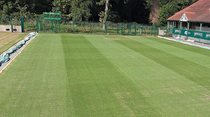
Match Court 4, ten days after completion of renovation (including seeding and top dressing)
Of course, as anyone who has dealt with Poa Annua will know, if left unattended a 2% sward presence in one year can very easily become 20% or more in two, and so whilst we needed to make compromises in our approach to renovating the courts, given the time constraints we were working with, we still needed to address the Poa Annua problem. The solution we looked to was Attraxor.
Circling back to the start of this piece, and our trip to BTME, Attraxor was recommended to us on two key points:
- Its qualities as a plant growth regulator - such products are used widely now within amenity horticulture, and the arrival of a new active ingredient is always going to be of interest.
- Its qualities as a Poa Annua suppressant - primarily through suppression of seed head production, but also for its ability to weaken even established plants over time.
To be clear, we know this doesn't sound like revolutionary stuff. Trinexapac-ethyl, the active ingredient in products such as Primo Maxx and Clipless makes similar claims. In fact, we'll vouch for its effectiveness as a plant growth regulator, and as such Primo Maxx has been a staple of our in-season chemical application programme for many years now. However, while we've always noted some seed head suppression associated with Poa Annua when using Trinexapac-ethyl, we've always viewed this quality as being a bit more hit and miss. Admittedly, Poa Annua suppression has never been the main aim of our Primo Maxx programme, and so any suppression has been a welcome side effect, but a product that could achieve a high level of Poa suppression while allowing us to manipulate growth would be a hugely impressive tool.
At the end of July, with the planning for our end of season renovations having highlighted the Poa problem, and armed with the knowledge of Attraxor's claims, we got in touch with Mark Allen (Technical Sales Manager at Agrovista) to see if he was aware of any venues that had been using Attraxor in the UK. Mark came back armed with some anecdotal evidence of the effect Attraxor had where it was applied in a stadium environment, and also shared images displaying its usefulness. The stadium in question was that of Gloucester Rugby, who had chosen to trial Attraxor on the strength of its Poa suppression claims. The photographic evidence we reviewed, coupled with the verbal testimony that we received from Gloucester's Groundstaff, via Mark, confirmed to us that Attraxor would be worth investigating further.
At this point, it's useful to get a better understanding of how Plant Growth Regulators, and in particular Attraxor work. It is generally accepted that there are five main types of Plant Growth Regulator:
- Auxins;
- Gibberellins;
- Cytokins;
- Ethylene;
- Abscisic Acid
Anyone familiar with products such as Primo Maxx, which utilise the active ingredient Trinexapac-ethyl, will know that the majority of Plant Growth Regulators that we use in the UK sports turf sector relate to Gibberellins, or more specifically, are Gibberellin synthesis inhibitors. Gibberellins are of particular interest to those of us who maintain turf because one of their main functions is to promote cell elongation within grass plants. In basic terms, they make the grass grow vertically.
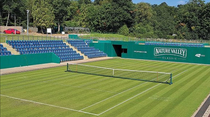
Centre Court set up for play during the playing season
The major upside to Trinexapac-ethyl has always been that it only inhibits vertical growth. Old school growth regulators were really growth retardants; they had the effect of holding a plant in a sort of suspension, effectively mothballing it, until the active ingredient had worn off. These sorts of products were purely made with the intention of reducing the need for more frequent mowing, and in many cases negatively impacted the overall health of the turf.
However, with the advent of active ingredients such as Trinexapac-ethyl, which only stop the vertical growth, we've been able to be more precise in how we regulate, or to be more accurate, manipulate the growth of the plants we look after. By inhibiting the Gibberellin activity within grass plants, we can pause vertical growth. However, the plant will still be carrying out all its other normal functions, and so the energy it is generating needs to be utilised in other ways. This is why these sorts of products are able to thicken grass swards; they cause the individual grass plants to push more resource into creating broader plant leaves which make the sward denser, as well as encouraging greater development of root systems.
Ultimately, this has been the reason why we've used Primo Maxx as part of our management of our courts for so long. We'd use it regardless of whether or not it induced a reduction in clipping yield (mowing); we're after the physiological changes it makes to the structure of the grass plant. It makes the surface denser, more wear resilient, and more aesthetically pleasing due to the improved uniformity.
In this context, it would be more than reasonable to ask us why we've decided to look at a different Plant Growth Regulator. After all, we've had no qualms with the effectiveness of Trinexapac-ethyl since we began using it. Indeed, one of my favourite pieces of advice to give to a groundsman is to stop and think about why you are doing something; if you can't explain why you are doing it, you almost certainly shouldn't do it!
For us though, the potential advantages of moving to Attraxor were too great not to at least consider using it, while the risks associated with moving products were minimal. On top of this, we also hypothesised a potential advantage in our scenario from using Attraxor, which would justify 'why' we were doing what we were.
The reason that the risks associated with at least trying Attraxor were, and continue to be, so low, is because it works in (certainly as far as we can tell!) broadly the same way as Trinexapac-ethyl. It inhibits the production of Gibberellin in the plant, causing a reduction in cell elongation or vertical growth, and redirecting the energy that would have overwise been used for this into other processes within the plant. In that sense, our view was that Attraxor would have broadly the same effect as products such as Primo Maxx as far as the physiological structure of the plant and sward were concerned. Therefore, there would be no concern that we would lose the benefits we have gained from Trinexapac-ethyl.
The reason for trialling Attraxor then, was actually connected to its reported ability to supress seed head production in Poa Annua. As we've stated, our biggest concern with our condensed renovation programme was going to be our ability to control Poa Annua going in to the 2021 season. This is what caused us to need to think differently, and possibly more swiftly than we normally would. There have been plenty of new things we've brought into our management of the courts over the last few years, but generally we introduce on one court and monitor, and then if results are positive we'll trial on a few more courts and keep increasing until we're comfortable using the new technique or product everywhere. However, the timeframe presented to us for 2020 meant that we needed to make a decision quickly, based on other people's anecdotal evidence, and any research we could find.
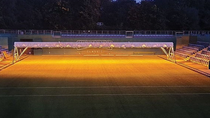
Lighting rig over Centre Court early morning
Fortunately, the body of research out there on Prohexadione was substantial enough to convince us that bringing Attraxor straight into use across all our courts during the end of the grass court season, and into our renovations, was the right thing to do. In interpreting the research we came across, we made two key observations.
Firstly, academic studies seemed to suggest that Prohexadione affects different grass species to a greater or lesser extent at a fixed dose rate. In the sources we read, the sort of range of difference indicated Poa species only required about a third of the amount of active ingredient that Ryegrass would require to illicit the same level of growth regulation. In other words, at a given dose rate Poa Annua is impacted around three times more than Perennial Ryegrass. By comparison, Trinexapac-ethyl seems to induce a fairly uniform response across different species at a fixed application rate; something we've noted when using the active ingredient, as well as being reflected in the reading we did.
Secondly, we came across sources that suggested Prohexadione created a more 'instant' effect on grass plants compared to Trinexapac-ethyl. These sources hypothesised that the fast-acting characteristic of Prohexadione, coupled with the relative strength of the product in its ability to effect Poa Annua caused a greater level of seed head suppression.
Equipped with this research, we therefore made the decision to switch to Attraxor for the applications of Plant Growth Regulator associated with our end of season renovations. For several years now, we've applied Primo Maxx after the courts have been cleaned out, but prior to seeding and topdressing. This has allowed us to slow the growth of existing grass within the sward in order that the new seed can establish, and topdressing settle before we need to get on to the surface to carry out initial mowing. This process has worked extremely well, and given our knowledge of Attraxor, we saw no risk in switching products to accomplish this.
We also caveated the decision to move to Attraxor with a safety net of sorts, that if we began to see any adverse results as we worked our way through the courts, we would withdraw from using the product for this year and revert to our normal way of slowly experimenting with new innovations until we were comfortable with the product's effects.
The first court to be renovated was our Centre Court; if we're honest it's the last court we would want to trial a new product on. However, with our hand forced, we carried out an initial application once the court had been scarified. We opted to utilise the full dose rate for a single application as set out by the product label (1.5kg per hectare) and applied with a small amount of nitrogen. We then completed the rest of the renovation procedures before leaving the court to settle.
Within a few days, we began to see evidence of the Prohexadione taking effect. On grass tennis courts, it isn't unusual for Poa Annua to be concentrated around the edges of the surface where the grass meets the surrounding concrete ring beam. Generally, this is because it is the most difficult area of the court to use mechanical equipment to remove poor growth, whether that is a tractor mounted scarifiers or pedestrian verti-cutting/brushing equipment. That problem is amplified on our courts, as when they were constructed just under a decade ago, the contractor did not allow for sinkage, and so we're still slowly, year-on-year addressing the fact that the perimeters of our courts sit higher than the grass! This means that we have a small strip of grass around the edge of our courts that has to be hand cut occasionally, and raked out manually if we want to thin it out at all.
This strip came in incredibly useful though, as it offered the first sign of some incredibly encouraging results. As the included pictures show, the Poa Annua around the edge of the court was, within days, beginning to suffer. Within a week or so, when we were able to get on to the court itself, we also found evidence of smaller patches within the main body of the court where Poa was starting to suffer, and be outcompeted by the new grass plants we had sown just a week or so prior.
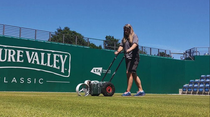
Sue Lawrence overmarking the Centre Court base-line during 2020 playing season
Unsurprisingly, with those observations, we didn't hesitate to continue rolling out Attraxor across our other courts as we renovated, and with weather proving favourable we applied a follow up dose to each court at twenty-one days after its initial dose. Visual results continued to demonstrate an ability to knock back the Poa, and allow the new grass to outcompete and take over where Poa populations were already thin, whilst on surround strips where mechanical works are trickier we were able to manually rake out the Poa before topping up seed and dressing. We should also point out that we saw no ill-effects with regards the desirable grasses within the sward.
With these observations, we circle back to our original point at the start of this article; We believe that Attraxor will prove to be the next revolutionary product to become commonplace in the turf manager's arsenal.
Despite that grand prediction, we should though issue some words of caution. Firstly, that our prediction is based on two applications made as part of our autumn renovations. While we see no reason to predict a significantly different outcome from using Prohexadione earlier in the growing season, we personally haven't done so yet, and so it would be wrong for us not to apply some caution to our words.
Also, while we've made quite a bold claim to the potential significance of Prohexadione, it isn't a silver bullet that is going to rid fine turf of the Poa species. No chemical replaces good, basic turf management, and there is no point applying the marginal gains that a chemical like Prohexadione offers if there are significant deficiencies in basic maintenance that will otherwise greatly undermine the chemical benefits.
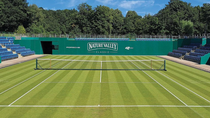
Centre Court set up for play during the playing season
That being said, we fully intend to continue experimenting with Prohexadione when spring arrives. It may well be the thing we need to keep the Poa at bay, and if it can do this while offering the same benefits to plant physiology that Trinexapac-ethyl has then we'll be on to a winner!
However, we wouldn't suggest that Prohexadione and products like Attraxor are going to be fully replacing Trinexapac-ethyl anytime soon. The ability of Prohexadione to knock back Poa Annua means that on swards which contain Poa, it is going to be a risky application, and while Attraxor offers label rates that appear 'safer' for Poa, applicators may be more comfortable using a product which has proven not to significantly impact Poa Annua. For example, on our site, many of our ornamental lawn areas and surrounds contain significant amounts of Poa, where it is perfectly acceptable as a species, as these areas aren't experiencing high levels of wear. While it would be advantageous to remove Poa from the site to prevent seed migration, the simple fact is our local geography would make this pointless - we're in a very green area where Poa would continue to come in from areas out of our control. For these areas, we'll continue, happily to use Primo Maxx as our chosen growth regulator, at least in the short to medium term.
Additionally, Attraxor may in some ways be too good at knocking back Poa. Imagine, for example, that hypothetically we had a court with a significant amount of Poa present during the week of our major televised event. Applying Attraxor may not be the best idea as it would likely highlight the Poa in the sward, by knocking it back and causing discolouring! Hopefully this won't be a problem for us, but it's definitely something to consider. In that scenario, it could be that Attraxor would be the right choice, up until a few weeks out from an event, at which point a switch across to Primo Maxx may be a good idea.
As we've said previously in this piece, and indeed as we've said previously about other products, Prohexadione, or Attraxor, isn't going to be a silver bullet that just eradicates a problem, never to be seen again. At the same time, we don't think Trinexapac-ethyl will be disappearing from our arsenal; there are far too many situations where it has proven to be invaluable to our industry. But, we really do believe it has the potential to revolutionise the way we maintain turf surfaces in this country. With the number of sports now that aim to play on 100% rye surfaces, or perhaps more importantly 0% Annual Meadow Grass, whilst also utilising a Growth Regulator Programme as part of a turf management strategy, it only seems natural that the two should converge. In that sense, don't be surprised if, in a few years time, Attraxor becomes a go to tool for turf managers in the UK.
Related News
Information: Use biocide products carefully. Always read the label and product information before use.
